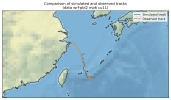junius.Wang
Member
Dear WRF community,
I'm encountering an interesting phenomenon in my WRF simulations of a typhoon track and I'm hoping to get some insights from the community.
Junius
I'm encountering an interesting phenomenon in my WRF simulations of a typhoon track and I'm hoping to get some insights from the community.
Setup:
- WRF Version: [V4.6]
- Input Data: NCEP FNL (ds084.1)
- Simulation Period: [2021.07.21.12:00-2021.07.25.12:00]
Observations:
I've run multiple simulations using different parameterization schemes, particularly varying the PBL & mu & cu & fdda schemes . I've uploaded images of the resulting typhoon tracks for each scheme, along with the JMA (Japan Meteorological Agency) observed track for comparison.Key Findings:
- Consistent Deviation: All simulations, regardless of the PBL scheme used, show the typhoon stopping at a similar location in the final stages of the simulation.
- Significant Bias: This common stopping point deviates significantly from the JMA observed track.
Possible Explanations:
- Model Limitations: There might be systematic limitations in WRF for this particular typhoon scenario.
- Initial/Boundary Conditions: If all simulations use the same initial and boundary conditions, errors in these could lead to consistent biases.
- Insufficient Physical Process Representation: Key physical processes affecting typhoon movement might not be adequately represented across different parameterization schemes.
- Resolution Issues: The grid resolution might be insufficient to capture small-scale features crucial for accurate typhoon track prediction.
- Large-scale Circulation Bias: There could be systematic biases in simulating large-scale circulation patterns that influence typhoon movement.
- Observational Uncertainties: While less likely, uncertainties in the JMA observational data can't be completely ruled out.
- Model Tuning: The model might be over-tuned to certain types of scenarios, leading to poor performance in this specific case.
Questions:
- Has anyone encountered similar consistent biases across different parameterization schemes?
- Are there known issues with WRF in simulating typhoons in this particular region or under similar conditions?
- What additional diagnostics would you recommend to further investigate this issue?
- Are there specific modifications to the namelist.input that might help address this problem?
Attached Files:
- Images of simulated typhoon tracks for different PBL schemes(Due to the limitation of the number of uploaded files, only some images are available))
- A sample namelist.input file
Junius
Attachments
-
namelist.input6.5 KB · Views: 14
-
 typhoon_track_typhoon_slp_data_wrf-pbl1_mp6_cu11_fdda2.png237.5 KB · Views: 15
typhoon_track_typhoon_slp_data_wrf-pbl1_mp6_cu11_fdda2.png237.5 KB · Views: 15 -
 typhoon_track_typhoon_slp_data_wrf-pbl1_mp24_cu16_fdda0.png239.9 KB · Views: 14
typhoon_track_typhoon_slp_data_wrf-pbl1_mp24_cu16_fdda0.png239.9 KB · Views: 14 -
 typhoon_track_typhoon_slp_data_wrf-pbl1_mp38_cu11_fdda2.png239.3 KB · Views: 13
typhoon_track_typhoon_slp_data_wrf-pbl1_mp38_cu11_fdda2.png239.3 KB · Views: 13 -
 typhoon_track_typhoon_slp_data_wrf-pbl2_mp24_cu11_fdda2.png239.1 KB · Views: 12
typhoon_track_typhoon_slp_data_wrf-pbl2_mp24_cu11_fdda2.png239.1 KB · Views: 12 -
 typhoon_track_typhoon_slp_data_wrf-pbl2_mp6_cu11_fdda0.png238.7 KB · Views: 13
typhoon_track_typhoon_slp_data_wrf-pbl2_mp6_cu11_fdda0.png238.7 KB · Views: 13 -
 typhoon_track_typhoon_slp_data_wrf-pbl2_mp38_cu11_fdda2.png239.9 KB · Views: 13
typhoon_track_typhoon_slp_data_wrf-pbl2_mp38_cu11_fdda2.png239.9 KB · Views: 13 -
 typhoon_track_typhoon_slp_data_wrf-pbl5_mp6_cu16_fdda0.png238.9 KB · Views: 14
typhoon_track_typhoon_slp_data_wrf-pbl5_mp6_cu16_fdda0.png238.9 KB · Views: 14 -
 typhoon_track_typhoon_slp_data_wrf-pbl5_mp24_cu11_fdda2.png238.9 KB · Views: 14
typhoon_track_typhoon_slp_data_wrf-pbl5_mp24_cu11_fdda2.png238.9 KB · Views: 14 -
 typhoon_track_typhoon_slp_data_wrf-pbl5_mp38_cu11_fdda2.png241.6 KB · Views: 15
typhoon_track_typhoon_slp_data_wrf-pbl5_mp38_cu11_fdda2.png241.6 KB · Views: 15

